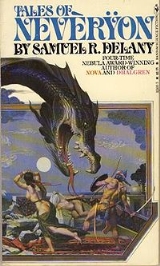
Tales of Nevèrÿon
Encyclopedia
Tales of Nevèrÿon collects a preface (to the entire series) and five sword and sorcery
stories by Samuel R. Delany
; and finally an appendix. The stories are "The Tale of Gorgik," "The Tale of Old Venn," "The Tale of Small Sarg," "The Tale of Potters and Dragons," and "The Tale of Dragons and Dreamers." It is the first of the four-volume Return to Nevèrÿon
series. This article discusses the five stories collected in the book. Discussions of overall plot, setting, characters, themes, structure, and style of the series are found in the main series article.
edition:
The 3rd printing of the Wesleyan edition of Tales of Nevèrÿon is currently the most accurate and corrects some errors from previous editions that might actually have confused some particularly careful readers of Delany's series.
and is taken to live in the castle of the Child Empress Ynelgo, back in Kolhari, where he gets his first taste of the advantages (and disadvantages) of life among royalty. Eventually the Vizerine frees him and secures him a commission in the army. Finally, however, Gorgik becomes an outlaw, for a while even working as a guard for a slave pen. But he is so disgusted by what he sees there that he goes back to being an outlaw, working to free all the slaves of Nevèrÿon, no matter their color. To this end, he makes use of some of the friendships he made while living at the court.
Sword and sorcery
Sword and sorcery is a sub-genre of fantasy and historical fantasy, generally characterized by sword-wielding heroes engaged in exciting and violent conflicts. An element of romance is often present, as is an element of magic and the supernatural...
stories by Samuel R. Delany
Samuel R. Delany
Samuel Ray Delany, Jr., also known as "Chip" is an American author, professor and literary critic. His work includes a number of novels, many in the science fiction genre, as well as memoir, criticism, and essays on sexuality and society.His science fiction novels include Babel-17, The Einstein...
; and finally an appendix. The stories are "The Tale of Gorgik," "The Tale of Old Venn," "The Tale of Small Sarg," "The Tale of Potters and Dragons," and "The Tale of Dragons and Dreamers." It is the first of the four-volume Return to Nevèrÿon
Return to Nevèrÿon (series)
Return to Nevèrÿon is a series of eleven “sword and sorcery” stories by Samuel R. Delany, originally published in four volumes during the years 1979-1987...
series. This article discusses the five stories collected in the book. Discussions of overall plot, setting, characters, themes, structure, and style of the series are found in the main series article.
Contents
The following table of contents is from the most recent Wesleyan University PressWesleyan University Press
Wesleyan University Press is a university press that is part of Wesleyan University in Middletown, Connecticut. The Press is currently directed by Suzanna Tamminen, a published poet and essayist...
edition:
- "Return . . . a preface by K. Leslie Steiner"
- "The Tale of Gorgik"
- "The Tale of Old Venn"
- "The Tale of Small Sarg"
- "The Tale of Potters and Dragons"
- "The Tale of Dragons and Dreamers"
- "Appendix: Some Informal Remarks Toward the Modular Calculus, Part Three by S. L. Kermit"
The 3rd printing of the Wesleyan edition of Tales of Nevèrÿon is currently the most accurate and corrects some errors from previous editions that might actually have confused some particularly careful readers of Delany's series.
The Tale of Gorgik
“His mother from time to time claimed eastern connections with one of the great families of fisher women in the Ulvayn Islands: she had the eyes but not the hair. His father was a sailor, who, after a hip injury at sea, fixed himself to the port of Kolhari, where he worked as a waterfront dispatcher.” So opens “The Tale of Gorgik” [1976].) In his youth Gorgik is one of the “brown, respectable” people of Kolhari, the major port of Nevèrÿon. When he is sixteen, because of a radical takeover of the government, Gorgik is captured and taken as a slave to work in an obsidian mine—not all the slaves are blond, blue-eyed barbarians. But the ones who are darker-skinned generally fare better than those who are not. Soon Gorgik is a mine foreman. When he is twenty-one, Gorgik is purchased by the Vizerine Myrgot as her catamiteCatamite
A catamite was a handsome youth kept as a sexual companion in ancient Rome, usually in a pederastic relationship. The word derives from the proper noun Catamitus, the Latinized form of Ganymede, the beautiful Trojan youth abducted by Zeus to be his companion and cupbearer...
and is taken to live in the castle of the Child Empress Ynelgo, back in Kolhari, where he gets his first taste of the advantages (and disadvantages) of life among royalty. Eventually the Vizerine frees him and secures him a commission in the army. Finally, however, Gorgik becomes an outlaw, for a while even working as a guard for a slave pen. But he is so disgusted by what he sees there that he goes back to being an outlaw, working to free all the slaves of Nevèrÿon, no matter their color. To this end, he makes use of some of the friendships he made while living at the court.
Themes and criticism
Bernard W. Bell points out that Tales of Nevèrÿon is thematically concerned with "the reversal of conventional hierarchical, oppositional relationships." Larry McCaffery states that Delany "thoroughly expands, deepens, questions, and undercuts the premises of [the sword-and-sorcery] genre".Further reading
- Tucker, Jeffery A. A Sense of Wonder: Samuel R. Delany, Race, Identity and Difference, chapter 3: "The Empire of Signs: Slavery, Semiotics, and Sexuality in the Return to Nevèrÿon Series". Wesleyan University Press, 2004. ISBN 0819566896

